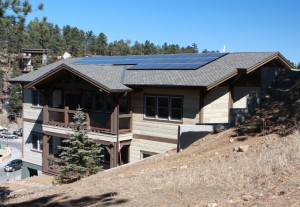Occasionally when designing small residential units the question comes up about what the minimum size is for a room and what the minimum ceiling height needs to be.
For single family homes and duplexes we go to the 2006 International Residential Code. It states that each dwelling unit shall have at least one room with a minimum of 120 square feet. Other habitable rooms need to have at least 70 sf excepting kitchens. (Bathrooms, closets, halls and utility spaces are not considered habitable rooms so they’re also exempt). In order to count the square footage towards the minimum it must have a flat ceiling over 7′-0″ or you can count the area under a sloped ceiling from the point it hits 5′-0″ and over.
There are also minimum ceiling height requirements under the 2006 IRC. Generally you need 7′-0″ clear minimum. Beams spaced 4′-0″ or more can be at 6′-6″ above the floor. Where you have basements with no habitable spaces (bedrooms, kitchen, living, etc) the ceiling can be at 6′-8″ and beams and ductwork can be at 6′-4″. Where you have the sloped ceilings at least half the room needs to have a ceiling height over 7′-0″. In bathrooms you need 6′-8″ over the fixtures and a minimum of 30″x30″ at that height where you have a showerhead.
The 2006 International Building Code kicks in for commercial buildings and buildings with more than 2 dwelling units. The room sizes are very similar to the IRC with a minimum of one habitable room over 120 sf and other habitable rooms needing to be 70 sf. Habitable rooms excepting the kitchen also have to be a minimum of 7′-0″ wide and there needs to be 36″ of clear space in front of counters and appliances.
On the minimum ceiling heights the IRC requires habitable spaces and corridors to be a minimum of 7′-6″ and bathrooms, kitchens, storage areas and laundry areas can have ceilings at 7′-0″ minimum. Where the ceiling slopes at least half the room needs to be over the minimum and you can’t count any area under 5′-0″ toward minimum room size. You can also furr down a ceiling to 7′-0″ for up to 2/3 of the room.
I haven’t utilized the rules for efficiency dwelling units but they exist in the 2006 IBC. For efficiency units you need a living room of not less than 220 sf and an additional 100 sf for occupants beyond 2. The unit has to have a closet. It also must have a kitchen sink, cooking appliance, refrigeration and a minimum of 30″ in front of each appliance. It also must have its own bathroom with a water closet, lavatory and a bathtub or a shower.











11 thoughts on “Minimum Room Sizes and Minimum Ceiling Heights”
Hello sir,
I want to built my home on my village, its my long day dream. it is 55 feet long & 20 feet width plot my doubt is what is min distance Exterior open spaces to be left out on both side of the plot? and how could i locate the rooms?. i want to built two storey building with three bed room.. pls suggest me…
Respected wir,
I have an area of 2000 sqf, length-100ft,width-20ft. How will i design it? Can give sugesstion/you help me? i.e. wich room for which location is suitable
Subho, those room sizes may work, the real question will be the layout of the rooms.
Lee, Anything in the IBC is applicable for properties with more than 2 units. For single family you just need to meet the IRC requirements.
I’m also interested in building a tiny home of about 200 sq ft and wondering if the “efficiency dwelling” rules would apply to it. It would be a stand alone small home on a lot zoned SF-2 in Austin (single family). I’m hoping that the “efficiency dwelling” rules in the IBC only pertain to multifamily properties.
Hi sir i have 3 family members,and i want to build a kitchen 7ft-8ft,and bathroom 6ft-7ft.will this size be enough for a single family?
Hi Sean,
I’m renovating an old 300sf building in my backyard that is designated on the tax record as a “living quarters”. It has a toilet, sink, gas heat, water heater, kitchen sink, and AC.
I just want to raise the 7′ ceiling to 10′ and 12′ sloped, add a shower, and put storage space above the bathroom.
Will the current efficiency dwelling space rules apply to my building? I’m concerned about the minimum 220sf area requirement. The interior space will be 9×24′ not including the walls or the bathroom. That’s 216sf. Plus I don’t have plans for a closet.
Would I be forced to enlarge the footprint to create 4 more sq ft of space to meet the requirement?
Thanks for the informative site,
Noah
Quinn, the ceiling height at 8′-5″ is fine. The trick will be any mechanical runs or other features dropped below the ceiling and maintaining clearances.
Hi Sean,
Would I be able to put a commercial kitchen in the basement of a building. The ceiling height is only 8′-5″? Thank you.
Best,
Quinn
Barbara,
First I should clarify that the 2006 code was the most up to date code when I wrote the post but the minimum ceiling height rules are not new.
It sounds like the room is non-conforming. It doesn’t mean that it can’t be counted or used. Many older houses have items that do not conform to the current codes. If you want to upgrade or renovate those spaces they’ll need to be brought up to code but you aren’t obligated to make older houses conform if you aren’t making alterations. The only real exception is if something is a life safety risk like a failing structure, but a low ceiling isn’t in that category.
I have a question about a lovely attic space that has been finished and used as living space. If the room was built before the 2006 International Building Code decreed that 7′ ceilings must cover half the room, does this mean that a room which was considered habitable space in 2005 is now not considered habitable space and that the room is no longer useful for purposes of appraisals, etc?
Thank you for your input,
Barbara
Comments are closed.